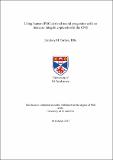Files in this item
Using human iPSC-derived neural progenitor cells to increase integrin expression in the CNS
Item metadata
| dc.contributor.advisor | Andrews, Melissa | |
| dc.contributor.advisor | Powis, Simon John | |
| dc.contributor.author | Forbes, Lindsey H. | |
| dc.coverage.spatial | x, 251 p. | en_US |
| dc.date.accessioned | 2018-11-28T13:03:28Z | |
| dc.date.available | 2018-11-28T13:03:28Z | |
| dc.date.issued | 2018-01-16 | |
| dc.identifier.uri | https://hdl.handle.net/10023/16567 | |
| dc.description.abstract | Repair of the adult mammalian spinal cord is prohibited by several extrinsic and intrinsic factors. As the CNS matures, growth-promoting proteins such as integrins are developmentally downregulated resulting in a reduced capacity for axonal outgrowth. Integrins are heterodimeric receptors involved in cell-cell and cell-matrix interactions. Specifically, within mature corticospinal tract (CST) axons, integrins are not transported into the axonal compartment. One integrin heterodimer, α9β1, is of particular interest for its ability to promote neurite outgrowth when bound to a component of the injury-induced milieu, tenascin-C. This project aimed to increase integrin expression within the CNS using induced pluripotent stem cell-derived human neural progenitor cells (iPSC-hNPCs). Using immunocytochemistry and western blotting, endogenous integrin expression within iPSC-hNPCs was determined. In addition, overexpression of α9 integrin was achieved using transfection and lentiviral transduction. The capacity of wild type (WT) and α9-hNPCs to extend neurites on tenascin-C was assessed using neurite outgrowth assays. Results revealed increasing α9 integrin expression in hNPCs significantly promoted neurite outgrowth when cultured on tenascin-C. Interestingly, increasing the concentration of human tenascin-C, resulted in increasingly longer neurites from WT hNPCs suggesting hNPCs could actively upregulate integrin expression. Subsequently, WT and α9-hNPCs were transplanted into layer V of the neonatal rat sensorimotor cortex, which projects to the CST. WT and α9-hNPCs survived up to 8 weeks post-transplantation and produced projections along white matter tracts, including areas of the CST. Additionally, hNPCs retained α9-eYFP protein expression in vivo over time and was localised within axonal projections. These results highlight the capabilities of iPSC-hNPCs to promote integrin expression within the rodent CNS presenting one potential avenue to target neuronal replacement following spinal injury. Future research should focus on assessing the regenerative capacity of WT and α9-hNPCs within an injury model concentrating on the ability of these cells to adapt within an injured environment. | en_US |
| dc.language.iso | en | en_US |
| dc.publisher | University of St Andrews | |
| dc.rights | Attribution-NonCommercial-NoDerivatives 4.0 International | * |
| dc.rights.uri | http://creativecommons.org/licenses/by-nc-nd/4.0/ | * |
| dc.subject | Neuroregeneration | en_US |
| dc.subject | Stem cells | en_US |
| dc.subject | Integrin | en_US |
| dc.subject | Brain and spinal cord repair | en_US |
| dc.subject | Transplantation | en_US |
| dc.subject | CNS | en_US |
| dc.subject.lcc | QP370.F7 | |
| dc.subject.lcsh | Central nervous system--Regeneration | en |
| dc.subject.lcsh | Integrins | en |
| dc.title | Using human iPSC-derived neural progenitor cells to increase integrin expression in the CNS | en_US |
| dc.type | Thesis | en_US |
| dc.contributor.sponsor | University of St Andrews. 600th Anniversary Scholarship | en_US |
| dc.type.qualificationlevel | Doctoral | en_US |
| dc.type.qualificationname | PhD Doctor of Philosophy | en_US |
| dc.publisher.institution | The University of St Andrews | en_US |
| dc.publisher.department | School of Medicine | en_US |
| dc.identifier.doi | https://doi.org/10.17630/10023-16567 |
The following licence files are associated with this item:
This item appears in the following Collection(s)
Except where otherwise noted within the work, this item's licence for re-use is described as Attribution-NonCommercial-NoDerivatives 4.0 International
Items in the St Andrews Research Repository are protected by copyright, with all rights reserved, unless otherwise indicated.


